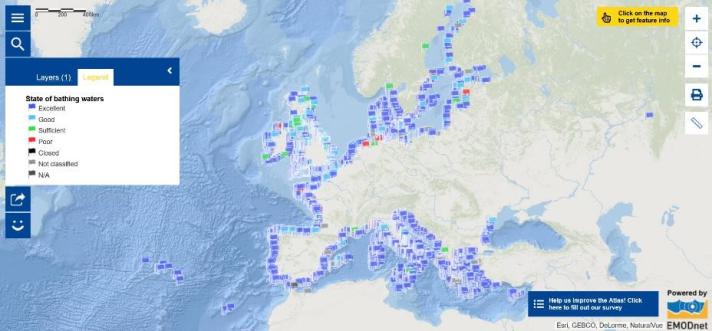Did you know there is a map layer on the state of bathing waters in the European Atlas of the Seas? A quick look at the map makes it possible to learn if the water quality at a beach site is excellent (dark blue), good (light blue), sufficient (green) or poor (red). Zoom in the map layer to see a specific coastal area and click on the flag. A window will open that will show the name of the beach, the bathing water status and the year. The first data you will see is the status for 2021. Click on the arrow at the top of the window to see the status in previous years.
The Bathing Water Directive requires European Union (EU) Member States to monitor and assess bathing water. The legislation specifies if bathing water quality can be classified as 'excellent', 'good', 'sufficient' or 'poor', depending on the levels of faecal bacteria detected. It ensures timely information is given to the public during the bathing season and requires Member States to disseminate information on bathing water quality actively and promptly. Where water is classified as 'poor', EU countries should take certain measures, such as banning bathing or advising against it, providing information to the public, and taking suitable corrective actions. Notices banning or advising against bathing should be rapidly and easily identifiable. Symbols are used to provide information on bathing water prohibition, advice against bathing and bathing water classification. These rules have led to a drastic reduction of untreated or partially treated municipal and industrial wastewater ending up in bathing water. The European Commission is currently reviewing the Bathing Water Directive. The aim is to examine whether the current rules are still fit for purpose to protect public health and improve water quality or if there is a need to improve the existing framework, notably by addressing new parameters. [1]
EU Member States must monitor bathing waters every year. Based on the information provided by EU countries, every year, the Commission and the European Environment Agency publish a summary report on the quality of bathing water and national country reports. [1] Key messages from the 2022 report indicate that [2]:
- Since the adoption of the Bathing Water Directive in 2006, the share of excellent sites has grown continuously; in 2021, it represented 84.8% of bathing sites in the EU.
- The quality of coastal sites is generally better than that of inland sites. In 2021, 88.0%, of EU coastal bathing sites were classified as being of excellent quality compared to 78.2% of inland sites.
- The share of poor-quality sites has dropped since 2013. In 2021, poor bathing waters constituted 1.5% of all sites in the EU, compared to 2% in 2013. This shows improvements in the management of poor bathing sites in Europe.
- The share of excellent bathing water has been stable in recent years. In the period 2015-2021, the share of bathing water having an excellent status in Europe has been stable at 85-88% for coastal bathing water; and at 77-81% for inland bathing water.
The data in this map are provided by EMODnet.
[1] https://environment.ec.europa.eu/topics/water/bathing-water_en
[2] https://www.eea.europa.eu/publications/bathing-water-quality-in-2021/european-bathing-water-quality-in-2021

